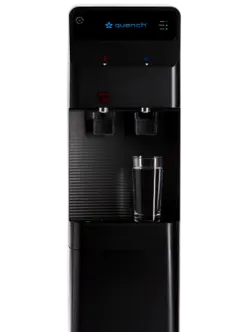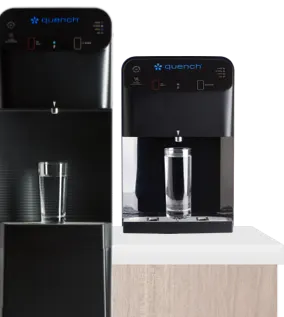There’s no one-size-fits-all solution when it comes to finding the right water filter, especially considering they serve several different functions. For example, some filters can make your water taste and smell better, while others might be more effective at removing or deactivating contaminants within your drinking water.
Read on to explore seven different water filters and the impurities they can remove, and take our quiz to find the best filter for your specific needs.
What Are Water Filters?
Proper hydration is essential to our health and well-being, and water filters play a pivotal role in providing access to clean and safe drinking water. Ideal for households and workplaces alike, filtration systems are designed to minimize the range of contaminants that compromise the quality of water, including:
- Sediments (e.g., sand, rust, and dirt)
- Chlorine and chloramines
- Heavy metals (e.g., lead, mercury, and copper)
- Microorganisms (e.g., bacteria, viruses, and parasites)
- Chemical pollutants (e.g., pesticides, herbicides, and industrial pollutants)
A drinking water filter serves as a protective barrier, mitigating potential health risks associated with such impurities. This underscores the crucial role of integrating advanced filtration into our daily routines.
7 Different Water Filters
Because each water filtering system serves a unique function, we’re taking a closer look at the most common types to consider and the main contaminants they’re designed to filter out.
1. Sediment Filtration
Image courtesy of Martin Water Conditioning
Sediment filters, the most common and fundamental water filters available, effectively eliminate large contaminants and dissolved solids larger than 10 microns — approximately the size of a grain of sand. While they can be used independently, they’re frequently combined with other filters.
Typically used in the initial stages of filtration, sediment filters excel at filtering out larger particles right away. This capability enhances subsequent treatment processes such as ultraviolet (UV) sanitization. How? Because when UV light is employed to eliminate bacteria in water, sediments can impede UV systems. Therefore, manufacturers often install a sediment filter as the first line of defense in a water filtration system to prevent clogging from larger particles.
According to research from the University of Nebraska at Lincoln, sediment filters mitigate:
- Sand
- Silt
- Dirt
- Rust
- Loose scale
- Clay
- Organic material
2. Distillation Systems
Image courtesy of geeksforgeeks.org
Distillation is one of the oldest methods of water purification. To distill, water is heated until it reaches a boiling point. As the water vapor rises and condenses, the resulting condensed water is collected for future use, leaving contaminants behind and discarded.
The International Water Association reports that distillation effectively removes:
- Arsenic
- Asbestos
- Benzene
- Fluoride
- Mercury
- Lead
- Nitrate
- Radium
- Radon
- Biological Contaminants
3. Ion Exchange

Image courtesy of envirogengroup.com
Ions refer to particles carrying either a negative or positive charge. Ion exchange systems effectively eliminate undesirable ionic contaminants by substituting them with harmless substances. For this exchange to occur, both the contaminant and the substituting substance must be dissolved and have the same type of electrical charge (i.e., either positive or negative). The ion exchange process is illustrated in the image above, where calcium ions replace similarly charged sodium ions — although less harmful.
Water softeners and deionization systems are common types of water filters that utilize the ion exchange process. These systems are best for removing soluble ions such as:
- Nitrates
- Arsenic
- Organics
- Minerals
- Chloride
- Sulfate
- Sodium
- Alkaline Earth Metals
- Nickel
- Copper
- Zinc
- Base and heavy metals
4. Carbon Filtration
Carbon filters use activated carbon to remove anything larger than five microns, or the size of a speck of flour. Activated carbon is packed like a sponge, with numerous holes that effectively trap and remove chemicals from water. Carbon filters are also able to attract and bond with any positively charged ions in the water, preventing the passage of chemical compounds such as chlorine.
This water purification method removes:
- Volatile organic compounds (VOCs)
- Chlorine (carbon filters are especially effective in removing chlorine taste and odor)
- Lead
- Fluoride
- Pesticides
- Chloride
- Herbicides
- Nitrate
- Forever Chemicals
- Phosphate
- Lithium
- Pharmaceuticals
- Microplastics
5. Reverse Osmosis
Reverse osmosis (RO) technology is at the heart of many drinking water systems. During the RO process, applied pressure pushes water through a semipermeable membrane (synthetic lining). When it moves through the semipermeable membrane, water moves from areas of high contaminant concentrations to low concentrations, effectively filtering out unwanted molecules and large particles such as metal ions and aqueous salts. RO also removes microorganisms, taking water purification to a molecular level and leaving behind only hydrogen and oxygen.
RO systems can rid water of up to 99.9% of all contaminants and sediments. They can filter out particles as minute as 0.001 microns, or the size of dissolved salt. It’s worth noting that RO removes essential minerals from water, emphasizing the importance of pairing an RO filter with one that reintroduces minerals back into the water.
A reverse osmosis system minimizes the presence of:
- Sodium
- Chloride
- Copper
- Chromium
- Lead
- Arsenic
- Fluoride
- Radium
- Sulfate
- Calcium
- Magnesium
- Potassium
- Nitrate
- Phosphorous
- Forever Chemicals
- Microplastics
Note: Although RO is highly effective in removing contaminants from drinking water, studies suggest that it doesn’t remove large amounts of chlorine, some pesticides, some organic chemicals, solvents, or VOCs.
6. Mineral Addback Filter
Often paired with an RO filter, a mineral addback filter plays a crucial role in enhancing your water source. While RO filtration is a lifesaving option in regions with high contaminant levels, consuming pure RO water poses risks. The World Health Organization (WHO) has reported that long-term consumption of demineralized RO water can deplete the body of essential minerals, potentially harming the intestinal mucous membrane and disrupting the body’s metabolism.
To address this concern, a mineral addback filter, certified by the FDA and NSF, is designed to reintroduce vital electrolytes and minerals to pure RO water. These filters commonly add calcium, magnesium, potassium, sodium, and other beneficial minerals, enhancing the water’s alkalinity and taste.
7. Polishing Filter
Image courtesy of waterandfilter.com
Positioned downstream of larger filtration systems, polish filters serve as the final safeguard in extensive water filtration processes. Polish filters act as the last line of defense, catching any leftover contaminants that may still be lingering at the end of the filtration journey.
Point of Entry Water Treatment vs. Point of Use Water Treatment Systems
When it comes to water treatment for homes and workplaces, you can choose between point-of-entry (POE) and point-of-use (POU) systems depending on your distinct needs. A POE system is installed at your water source’s entry point, where the water is treated before it reaches any specific outlet. This method is generally ideal for addressing broader concerns, such as reducing contaminants in bathing water or protecting appliances. POU systems, on the other hand, are localized solutions designed for specific exit points. As a result, this type of treatment is more targeted, addressing concerns at individual water access points. They also offer flexibility to address unique concerns and provide tailored solutions.
Answering Water Filter FAQs
Take a closer look at some of the most commonly asked questions about water filtration systems for homes and workplaces:
How Do Water Filters Work?
A water filter system works by using different mechanisms to remove impurities. While we’ve covered some of the most common types of filters above, other alternatives include physical barriers like membranes, chemical processes like activated carbon adsorption, and sequestration. These processes are ultimately designed to trap, absorb, or exchange contaminants, ensuring you have access to a cleaner and safer water supply for consumption.
Do Water Filters Remove Taste and Odor from Tap Water?
If you’ve recently noticed any off-tastes or smells coming from your water supply, a filtration system is an effective way to address these issues. Many filters, particularly those with activated carbon elements, adsorb and eliminate the compounds behind these unpleasant outcomes. The result is filtered water with improved overall taste and odor quality.
How Do I Know What Water Filter is Best for My Needs?
Still not sure which water filter is best for your unique situation? To determine the ideal option you need, consider factors like the types of contaminants present (i.e., your local water quality), your budget, and the scale of filtration you’re looking for. Identifying specific concerns, such as removing chlorine, heavy metals, or microorganisms, will serve as the best guide to selecting an adequate filter.
Feel free to try our product finder and get matched with the system that meets your needs, or speak with one of our Quench Water Experts to learn more about the water quality in your area.
Can Water Filters Address Hard Water Issues?
Keep in mind that while a combination of water filters can be highly effective at minimizing impurities in drinking water, they’re not generally designed to address hard water issues. If you’re seeking a solution to tackle hard water, a water softener is more effective; using ion exchange to reduce mineral content and preventing issues like limescale buildup. For those concerned about hard water, consider incorporating a dedicated water softening system in addition to your chosen water filtration system.
What is quenchWATER+ Filtration?
No single filter can effectively tackle all existing contaminants. Therefore, the best way to safeguard yourself from impurities is to find a water filtration system that combines multiple filters in one.
Take the quenchWATER+ filtration system, for example. This system combines five water filters into one dispenser. It starts with a sediment filter to get rid of all the larger dissolved solids. After passing through the sediment filter, tap water will move to the pre-carbon filter, where anything larger than five microns is removed. The third stage employs RO filtration to eliminate remaining contaminants larger than 0.001 microns. Subsequently, a mineral addback system adds essential minerals like calcium, magnesium, potassium, sodium, and others back to the water supply. The final phase of this five-filter process involves a polishing filter, effectively clearing the water of any lingering sediments and impurities.
Get a Water Dispenser With an NSF-Certified Filter for Your Business
Because Quench conducts over 260,000 water quality tests annually, we’ve built one of the most extensive water quality databases. This wealth of information enables us to precisely determine the filtration system suitable for each customer. Our team of trained and certified water experts is standing by to advise you on the optimal water filter and filtered water dispenser for your needs.Ready to get started? Get a free estimate today to embark on your path toward a healthier, more hydrated future.
















